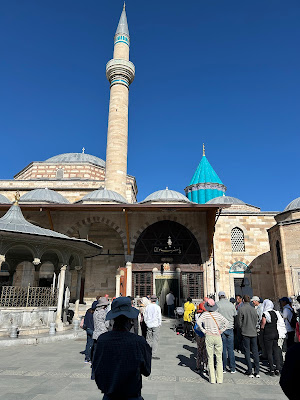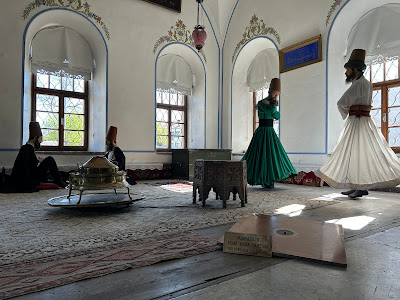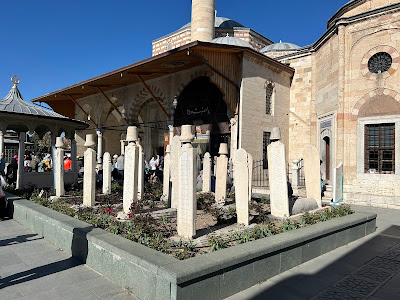The city of Konya, our next stop, is currently the sixth largest city in Turkey. A city in this location has been here since the time of the Hittites; Phrygians, Persians, Greeks, Romans, and Byzantines all knew this city, which from the Greek to Roman Era was known as Iconium. The Apostle Paul and Silas traveled here during one of their missionary journeys. The city fell to the Seljuk Turks in A.D. 180 after the Battle of Manzikert in A.D. 1071 opened the Anatolian plateau to them.
 |
| (Source) |
The Seljuks held the city until A.D. 1307, where served both as a major city and as the capitol of the Seljuk empire following the loss of Nicea. The city was then held by smaller Turkish entities until it fell to the Ottoman Turks in A.D. 1420. Since that time, it has been a Turkish city.
As an aside, it is also considered a very conservative city - "Not one of my favorite cities in Turkey", per our guide. Of note, they sounded all five calls to prayer, including one at 0430 or so. A bit of surprise when the minaret is right outside your hotel room.
Jalal al-Din Muhammed Rumi (A.D. 1207-1273), often just known as Rumi, was a jurist, scholar, poet, and mystic. Of Persian descent, he wrote in mainly in Persian but also in Turkish, Arabic, and Greek. A Sufi mystic, his son and his followers founded the Mevlevi order of Sufi mysticism.
The Mevlevi order, like many things, is a lot more complex that what can be described here. Suffice it to say for our purposes that the order seeks unity with God through a number of practices - include the sema, a whirling ceremony during which the semazens performed dikhr, or remembrance of God. They hope through the focus of the ceremony and the inward mediation on the name of Allah they can reach him through an ecstatic trance.
We know them mostly as The Whirling Devishes.
Rumi is known for his many writings; his most famous is The Masnavi, which was composed in Konya during his stay there. I bought a copy at the site and finished it earlier this year; I feel like the translation was a bit rough as I did not get as much out of it as I have read in his quotes.
The Mevlevi order was headquartered here for over 750 years until it was closed down as part of the radical post-Ottoman efforts by Kemal Ataturk. It is now technically illegal in Turkey, although it likely lives on in private practices or as a cultural ceremony.
Some dioramas at the site of daily life. The headgear is distinctive; it embellishes the tombs of all the Sufi dervishes buried at Konya.
Rumi is revered by any number of nations and language groups, who claim him as their own.
The distinctive turbans on gravestones:














Interesting. I don't recall hearing of Rumi. I've heard of the Whirling Dervish, of course, but had no idea about any of it. One thing I noticed is how nicely they've blended the more ancient with modern architecture.
ReplyDeleteLeigh, Rumi is one of those people that I did not think I had heard of either, until I found in my Book of Face feed from years ago a post from him. So I accidentally knew of him at best. Likewise with the Whirling Dervish - I had heard of them, but had no idea where they were from or their history.
DeleteI will say that - at least for the places we visited - the blending of architecture was overall very well done. They seem to have respected the historical sites greatly.
This post certainly increased my knowledge base of the Dervish order TB.
ReplyDeleteNylon12 - My visit did as well. They were one of those "vague sects" of Islam. I have to confess after my visit, they were quite interesting to read up on.
DeleteWatching a PBS Focus on Europe, that is portraying sinkholes around the Konya area affecting farmers.
DeleteNylon12 - I wonder if it was tied to the rock formations or some other factor. Konya is getting near to Kappadokia, which definitely has less "hard" rock.
DeleteFascinating! Thanks for sharing! Such rich history.
ReplyDeleteAnon. - You are quite welcome. I have to admit this was one of the really fascinating parts of the trip that I had not at all anticipated. I knew of the whirling dervishes; I had no idea their start was in Turkey.
DeleteI love Rumi. I had no idea you could visit his tomb.
ReplyDeleteSandi, nor did I. It did not click almost until we were there that it was that "Rumi".
Delete